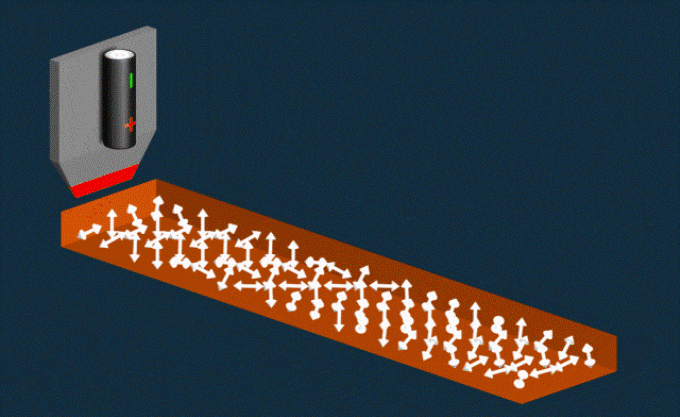Jan 12 2017
 In the experiment, the scientists moved the electric tip along the surface and applied a positive voltage. The electric field aligns the spins of the electrons in the nonmagnetic material, and the ordering creates magnetic properties. If the voltage is reversed, the spins once again become disordered and magnetism is lost. The researchers were able to see the changes using X-ray microscopy at the Stanford Synchrotron Radiation Lightsource. Credit: SLAC National Accelerator Laboratory
In the experiment, the scientists moved the electric tip along the surface and applied a positive voltage. The electric field aligns the spins of the electrons in the nonmagnetic material, and the ordering creates magnetic properties. If the voltage is reversed, the spins once again become disordered and magnetism is lost. The researchers were able to see the changes using X-ray microscopy at the Stanford Synchrotron Radiation Lightsource. Credit: SLAC National Accelerator Laboratory
Researchers drew magnetic squares in a nonmagnetic material with an electrified pen in a proof-of-concept study featured in Nature Physics. This magnetic doodle was then read with X-rays.
The experiment demonstrated that magnetic properties can be created and annihilated in a nonmagnetic material with accurate application of an electric field, something that was studied for a long time by scientists on the look out for an enhanced way to store and retrieve details on hard drives and other such magnetic memory devices. The study was conducted at the Department of Energy’s SLAC National Accelerator Laboratory and the Korea Advanced Institute of Science and Technology.
The important thing is that it’s reversible. Changing the voltage of the applied electric field demagnetizes the material again. That means this technique could be used to design new types of memory storage devices with additional layers of information that can be turned on and off with an electric field, rather than the magnetic fields used today. This would allow more targeted control, and would be less likely to cause unwanted effects in surrounding magnetic areas.
Hendrik Ohldag, Scientist, Stanford Synchrotron Radiation Lightsource (SSRL)
“This experimental finding is important for overcoming the current difficulties in storage applications,” said Jun-Sik Lee, a SLAC staff scientist and one of the leaders of the experiment. “We can now make a definitive statement: This approach can be implemented to design future storage devices.”
Lining Up the Spins
The orientation of the electrons’ spins help to determine the magnetic properties of a material. All of the electron spins are lined up in the same direction in ferromagnetic materials, found in refrigerator magnets, hard drives and compass needles. It is possible to manipulate these spins by applying a magnetic field, flipping them from north to south, for example, to store details as zeroes and ones.
Scientists have been using a variety of ways to develop a “multiferroic state,” in which it is possible to manipulate magnetism with an electrical field.
This has become one of the Holy Grails of technology over the past decade. There are studies that have shown aspects of this multiferroic state before. The novelty here is that by designing a particular material, we managed to both create and eliminate magnetism in a controlled fashion on the nanoscale.
Hendrik Ohldag, Scientist, Stanford Synchrotron Radiation Lightsource (SSRL)
Crosstalk Between Electricity and Magnetism
In this work, the researchers started with an antiferromagnetic material comprising of small magnetism patches that cancel each other out, so that this material does not totally behave like a magnet.
Both ferromagnets and antiferromagnets show magnetic properties only below a specific temperature, and they become non-magnetic above that temperature.
The researchers designed an antiferromagnetic material doped with the element lanthanum and discovered the possibility of tuning the properties of the material in a manner that both magnetism and electricity could influence each other at room temperature. The magnetic properties could then be flipped with an electrical field.
These changes were observed by the researchers when they tuned a scanning transmission X-ray microscope at SSRL so it could identify the magnetic spin of the electrons. The X-ray images proved that magnetization had occured, which was truly reversible.
The researchers next plan to test other materials in order to analyze if they could discover a way to make the effect a lot more well-defined.
The research team was made up of scientists from the Korea Institute of Materials Science, Pohang University of Science and Technology, Pohang National Accelerator Laboratory, Max Planck Institute for Chemical Physics of Solids and the University of New South Wales of Australia.